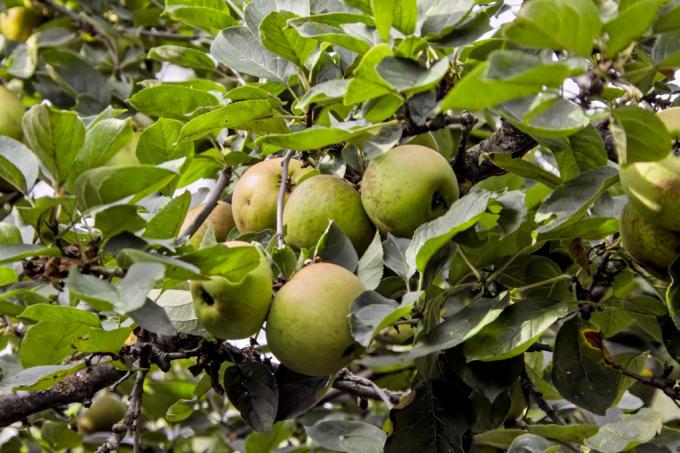The Zabergäu-Renette apple is an old and easy-care variety that is often eaten as a table apple. We reveal what the 'Zabergäu Renette' apple variety tastes like, how to recognize it and what special features you need to consider when growing it.

If you are looking for an easy-care, high-yielding apple variety, 'Zabergäu Renette' could be the right choice for you. Among the numerous apple varieties 'Zabergäu Renette' is a rather unknown variety from the group of reindeer. 'Zabergäu Renette' has numerous advantages that make it particularly attractive for hobby gardeners makes: These reindeers are characterized in particular by their mild, sweet and sour aroma, but also by their easy-care nature the end.
contents
- ‘Zabergäu Renette’: profile
- Origin and history of the apple variety
- Characteristics and taste of the 'Zabergäu Renette'
- Peculiarities during cultivation
- Harvest time and use of the 'Zabergäu Renette' variety
‘Zabergäu Renette’: profile
| synonyms | 'Zabergäu', 'Hausen Gray Renette' |
| fruit | big; green with reddish striped tint |
| the taste | sweet and sour, juicy |
| yield | medium; tends to alternance with age; early onset |
| harvest time | from October on |
| maturity | from November on |
| shelf life | very good; can be stored until March |
| growth | initially strong, later weaker |
| climate | widely cultivated; not very frost hardy; susceptible to powdery mildew in very warm areas |
| diseases and pests | susceptible to fruit tree canker and specks |
Origin and history of the apple variety
The apple variety 'Zabergäu Renette' was created in 1885 in Hausen an der Zaber in Baden-Württemberg and named after the area of the same name. The strain is a chance seedling, so it was not bred by design. The 'Zabergäu Renette' is also known under the names 'Zabergäu' or 'Hausener Graue Renette'.
Characteristics and taste of the 'Zabergäu Renette'
The Zabergäu Renette scores particularly well with its large, evenly shaped apples, which can weigh up to 210 grams. The skin of the fruit is leathery and green, but when ripe, the Zabergäu Renette apples show a light reddish striped colour. The cinnamon-brown rust, which often covers the entire apple, is particularly decorative. In storage, the color of the apples then turns yellowish.
The taste of the Zabergäu-Renette apple in particular convinces many people: it is slightly sweet and sour, but less acidic than the variety 'Lovely from Boskoop'. The flesh is yellowish, medium-firm and juicy. During storage, however, the apples increasingly lose acidity and become brittle.
Peculiarities during cultivation
The 'Zabergäu Renette' apple variety is particularly impressive when young with its strong growth, which decreases significantly with age. The Zabergäu-Renette apple is particularly popular because of its high resilience and its easy-care nature. The late and long-lasting flowering ensures low susceptibility to frost, and the variety is also hardly affected by scab. As a result, 'Zabergäu Renette' is considered to be particularly reliable. With increasing age, however, the apple tree tends to alternate, which means that its fruit yield fluctuates greatly every two years. Another disadvantage of the 'Zabergäu Renette' apple variety is the trees' increased susceptibility to cancer. In addition, some of the fruits tend to have specks, a deficiency symptom that manifests itself in small brown spots. Since it is a triploid apple variety, it is unsuitable as a pollen donor and needs apple trees of other, diploid varieties nearby in order to be pollinated. Likewise, the 'Zabergäu Renette' cannot serve as a pollinator for other apple trees. Good pollinators are ‘Laxtons Superb’, 'Elstar', 'Cox Orange', 'Golden Delicious', 'gold parmane' and 'Klarapple'.

Harvest time and use of the 'Zabergäu Renette' variety
From October the apples of the 'Zabergäu Renette' are ready to be picked. They are then ready to eat from November. From this point on, Zabergäu-Renette apples prove to be a real all-rounder. From fresh consumption to applesauce and cider, there are almost no limits to the use. The 'Zabergäu Renette' is also ideal for baking in the cold season. But if you can't process all the apples at once, you don't need to worry: the 'Zabergäu Renette' shines with one particularly good shelf life - the apples can be stored without any problems until March - but are becoming more and more popular flourier. You can find out how best to store the 'Zabergäu Renette' apples over the winter in our article on the right one storage of apples.



